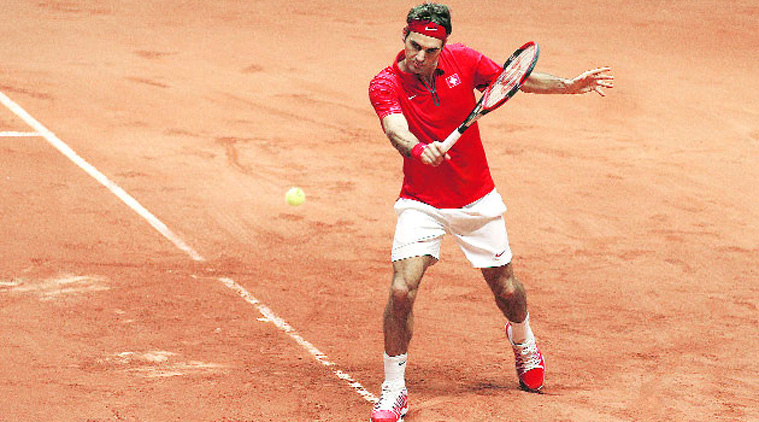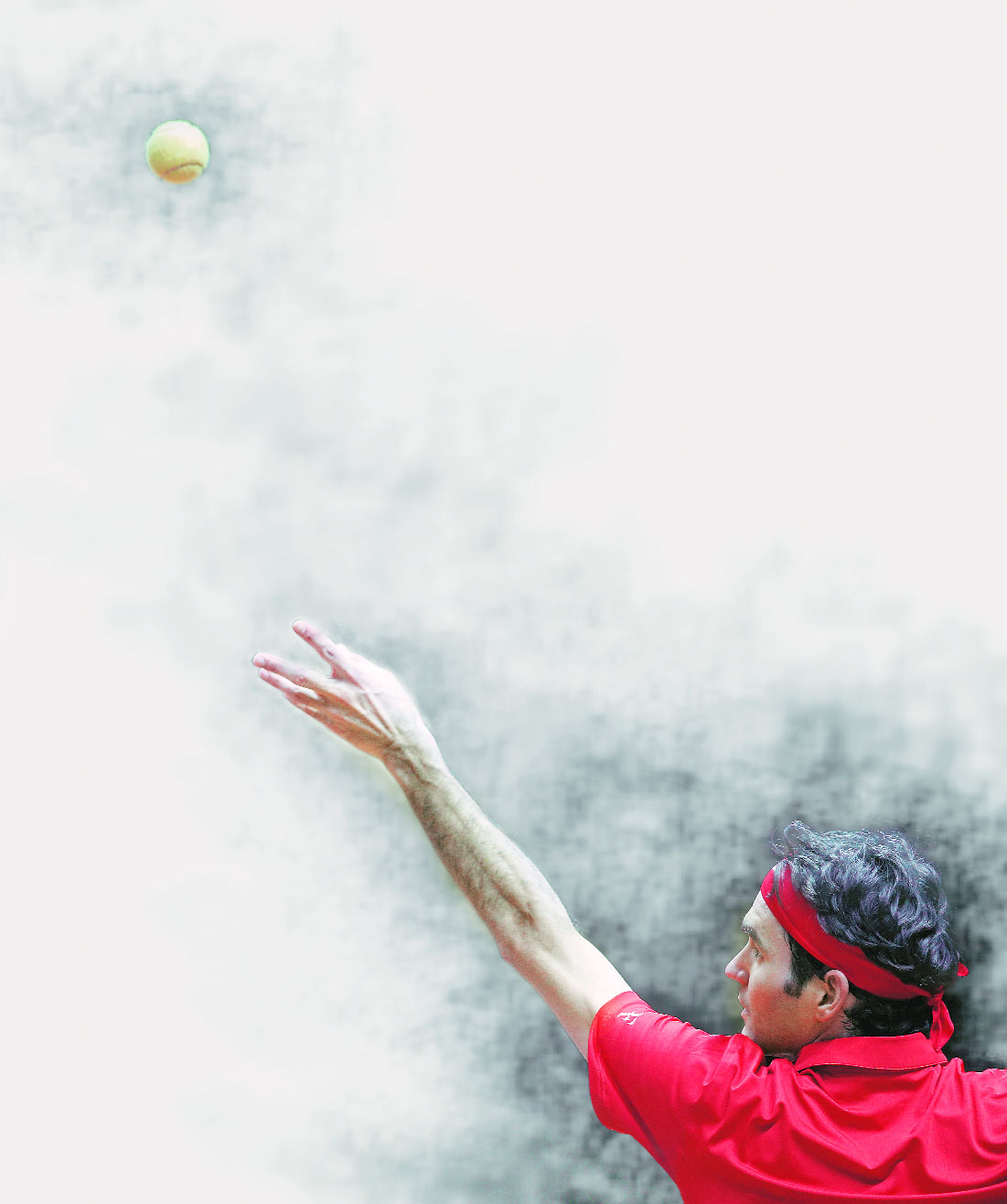The Last Days of a Beautiful Game
 Grace under fire: Roger Federer at the Davis Cup final against France, where he led Switzerland to a win. (Source: AP)
Grace under fire: Roger Federer at the Davis Cup final against France, where he led Switzerland to a win. (Source: AP)Like the flame burning bright before its end, this was the year of Roger Federer and the single-handed backhand. As athletes and bodybuilders conquer tennis, Sandeep Dwivedi bids adieu to an age of elegance.
Back in the day, the mid-1980s to early 1990s to be specific, being a Stefan Edberg fan was exhausting and expensive. You were mostly in a minority, fighting long, lonely battles trying to explain the pristine “Edberg grace” to the loudmouths who supported John McEnroe and Boris Becker — they were also hard of hearing. You knew it was futile but you still tried, like you did when you wanted to be “Edberg” on a tennis court. As teenagers, you are entitled to unrealistic dreams.
Trying to pull off the Swede’s heavy top-spin serve, that too with an inwardly locked wrist, would result in the ball hitting the racket frame and the mis-hit leaping over the tall wall beyond baseline. You helplessly watched money being blown away. The precious wooden racket would crack while you foolishly rushed to the net like the fleet-footed champion to counter a speeding, dipping return with a valiant volley. Fresh tight strings would snap after a sloppy attempt to hit that one shot which defined Edberg — the single-handed backhand. Being Edberg really hurt your pocket; make that your father’s pocket.
For us amateurs, those volleys and the backhand, so easy on the eyes when the master played it, were ridiculously difficult to pull off. Settling for an easier alternative was not an option. No first-round exit at a club tournament or any other humiliation on court would lead to thoughts of giving up. You either played like him or you didn’t. With time, the obsession turned into a habit. For years now, I regularly YouTube the Edberg backhand. Back then it was to learn, these days to merely savour.
Then, at the start of this year, out of the blue, Edberg returned to the sports pages and the Grand Slams. His latest assignment was to resurrect the career of his one-time fan and now the most successful tennis player of all times, Roger Federer. They were two of a kind, very similar in temperament, and they both had virtually the same backhand. With the best-ever volleyer as his coach, Federer started approaching the net more often and thus shortening the rallies. He looked charmingly vintage and his ageing limbs less tired.
As the tennis season ended last week, the Swiss with the Swede by his side would be a step away from the No.1 ranking. By finishing the year strongly, the 33-year-old, written off last year, has stayed relevant, and so has his brand of tennis. The delightfully elegant one-handed backhand might be on the verge of extinction, but two of its best exponents has extended its lifespan.
For the uninitiated, or the less-obsessed, here’s a short foreword about the much-hyped Edberg backhand. It starts with a big back swing that peaks well above the head. For a brief moment, just as the racket moves down, the non-playing hand lovingly feels the racket’s neck. It’s nothing more than a quick, limp handshake, a gentle reminder to start the lazy sweep. By then the ball is within striking distance. The knees bend and the racket, held by one hand now, first flows down with the smoothness and energy of a waterfall, and after hitting the ball, climbs up in the follow-through like a rising wave. The racket swoosh can be easily imitated but not that final flick of the wrist that decides the direction and trajectory of the ball. That subtle change of position of fingers and palm can’t be captured on cameras, or seen by fans and is thus immunised to any imitation. You need to be on court to understand it, and spend years to master it. It’s something Edberg and a few of his successors, and my other favourites, seemed to be born with.
Ironically, those “other favourites” and I didn’t really hit it off instantly. I hated Pete Sampras for beating Edberg so consistently in 1993 and 1994. Strangely, within months of the likeable Swedish star’s heart-breaking retirement at Malmo — failing to complete a Davis Cup final match because of injury — there I was cheering for Sampras. His tennis had Edbergian elegance and the same pure backhand; he was also more successful. That helped since you were no longer in a minority in the fan zone. You had for company the fair-weather supporters, who unfailingly root for the No.1. Sampras was an unquestionable all-time great, he was also a nice guy who mostly won. 
Then one day, a 19-year-old from Switzerland, wearing a thick, schoolgirl headband and coloured beads around his neck, sprouted on the Wimbledon grass. Shockingly, he ended Sampras’s long streak on that hallowed turf. That was 2001. You hated Federer, called him an upstart and even wished he was another Peter Doohan, the Aussie who upset Becker in 1987 and disappeared after that. Federer didn’t fade away. Thank god, he didn’t and still hasn’t. He ensured Sampras wasn’t missed, he was the reason you watched Grand Slams, he was the only connect you had with the style of tennis you loved. (Disclaimer: the hyper-sensitive among the Rafael Nadal fans should stop reading and move to the next page.
Post-Sampras, in the crowd of men with rippling muscles, towering frames and ultra-flexible limbs, the frail Federer, with his measured footwork, continued to retain the original look of a tennis player and that old-school court demeanour. He was lean, not muscular; agile, not a super-athlete; he floated around the court but didn’t scamper about as if being chased by muggers in a dark alley. That’s because the single-handed backhand was gorgeous, effortless, almost VVS Laxman. Double-handed was laboured, manufactured, and Matthew Hayden.
That poetry in motion was fine, but Federer no longer alluded to as the best. Athletes, bodybuilders and gymnasts conquered the court and won Grand Slams. Tennis had fewer men who could hit those aesthetically enriched strokes which stayed in the mind for years, and far more robots who shuttled on the baseline getting their racket under impossible balls before they bounced the second time.
With time, these tastes have also changed. The standing ovations these days are mostly in appreciation of the tireless “right-left, left-right” regimented backcourt sprints or a gymnast-like split by the ultimate retriever on the baseline. The majority of points end when a tired slugger nets the ball or hits it long. The threading-the-needle impossible pass (Sampras), a stinging cross (Edberg) or a diving volley (Becker) of past that would spark awe in the stands and signal the end of a short, crisp rally are far too few now.
Thrilling contests do take place but monotony has affected the modern game. There are a number of factors responsible for reducing most contests to a baseline slugfest: the courts slowing down, the balls not flying like they used to on Wimbledon grass. But the game-changer has been the “top spin”. New-age rackets, slim polyester strings that guarantee more spin plus better control, semi-Western grips and gym-manufactured arms, all combine forces to make the ball travel in parabola and stand up after bouncing. The top-spin happens to be a far more consistent stroke than the flashier flat slap, the bread-and-butter shot of players till very recently. This highly deceptive shot has a big role to play in making the one-handed backhand an endangered panda on the tennis ecosystem.
Had Nadal been playing in the 1980s, he would have exploited Edberg’s backhand with his top-spin forehand, like he does so often against Federer. When Nadal’s kicking, screaming top-spin forehand that climbs to the opponent’s head is unleashed, it is tough to bring it down and push it deep across the net with just one hand on the grip. As any Indian cricketer abroad, especially the wristy ones, will tell you, it is always difficult to dominate a ball that takes off after pitching. Likewise, the single-handed backhand, with the accompanying exaggerated swing, is tough to pull off against the high ball. Double is better.
On a circuit crowded with top-spinners, Federer has remained competitive and also in the top 3, despite his old ways. But lesser mortals can’t. Go to any local tennis court near your home and you will see coaches teaching children the art of brushing the ball to impart it spin with the forehand and asking them to play the double-handed backhand. A recent survey showed that there are 76 players in the men’s top-100 who used both hands to play the backhand. The corresponding number in the boys’ section rises to 95 and in the girls’ category it’s 99. Contrastingly, till the late 1960s, not really ancient history, tennis was universally played with one hand.
Despite that, 2014, almost magically, proved to be the Year of the Dinosaur, of the single-handed backhand kind. It started with Stanislas Wawrinka, Federer’s country-mate and a single-hander, winning the Australian Open defeating the top biggest top-spinner the game has ever seen, Nadal. Federer, after running Novak Djokovic close, joined forces with Wawrinka to help Switzerland win the Davis Cup final against France.
To see this as a second wind for the single-handed backhand is to again be a teenager with unrealistic dreams. This is just the flame burning brightest before it extinguishes. For years, there hasn’t been an upstart you once hated the way you did Sampras for beating Edberg and Federer for beating Sampras. This long-running show is unlikely to last longer. The day is not far when many a romantic will gather to condone the demise of that delightfully elegant shot. The mourners will have a racket in one hand and the other will be free to raise a toast and, later, wave a heartfelt goodbye.





